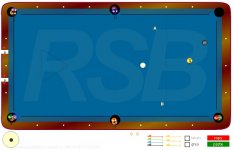CaptainJR said:
I didn't mean to knock others just because they are different. I did get a little carried away when I said what I said about Hal's system. I shouldn't have said that because I don't know that system. From what was said I got the impression that it wasn't based on the contact point of the object ball. If it doesn't include the contact point on the object ball, it can't work. Unless it really does include the contact point without even mentioning it. That could be possible I guess. Reiterating what I said in post #100 in this thread. If you don't have the contact point on the object ball, either consciously or subconsciously you have nothing to base a line or angle on. Some where in your aiming you must see the path that the object ball is going to take on it's way to the pocket. What is at the beginning of that path? The contact point. The better you get, the more often knowing where the contact point is in the subconscious. (being able to play the shot by feel) The more often it is subconscious, the more thought can be put to cue ball speed, english, etc.
Now that we have brought up compensating for english, throw, deflection, cue ball speed, etc. If you start including this, you darn well better start including the contact point in your thinking. Example in below shot on the 8 ball. The two obvious shots, either more than a little left english (cue ball position A for the 9 ball shot) or more than a little low right english (cue ball position B for the 9 ball shot) Either way this is certainly a feel shot, but in that feeling you better have a contact point in mind and you better be looking at it when you pull the trigger. I would prefer the left english, A position shot. Trying for the B position you may be taking a chance on hitting the 9 and with the wrong role you could end up with a bank shot.
Conclusion... The contact point being so important in a difficult shot such as this illustration. It only makes sense that having a contact point in mind will help you make easier shots more consistently.
Personally, I'm a contact point aimer as well, and would probably be willing to assume most people are. But, I'm open-minded enough to consider that other players, even good ones, may have different techniques.
One of the things that is going to obscure this issue, is that most (not necessarily all) aiming techniques are going to include a contact point in some form in it. While some may not have a distinctly defined contact point. Examples of aiming techniques
- look directly at contact point and shoot
- find contact point, imagine ghost ball then shoot
- find contact point, imagine ghost ball, imagine line between center of cue ball and center of ghost ball, ensure cue stick is on that line, then shoot
- find an angle which will lead you back to a distinct or non-distinct contact point
- find object ball destination path, and roughly locate some ambiguous contact point that'll send your object ball on that line
- look at pocket/destination and then shoot at object ball (another example whereby the contact point may or may not be very ambiguous).
- even heard of some system whereby players looks at object ball, then looks at cue ball, based on the type of english they use determines where to contact the cue ball, and shoots. As he explained it, no calculations at all. Good player. I could never duplicate what the player tried to relay....
- then of course the beginners, or clueless ones, just fire away and hope
I think you're talking about a very distinctly defined contact point. Then there are other systems that have a nondistictly defined contact point, whereby the shooter may not even be conscious of any contact point. Finally there may be some other systems that use something like, touch, feel, experience.... where they may use no contact point at all.
In the end, you can boil everything down to some contact point, because basically every shot is pocketed using some form of contact with the cue ball.
To limit this discussion of aiming techniques to contact points might be as fruitless as limiting the discussion to object ball paths, since every shot is going to result in an object ball path. Or limiting the discussion to cue ball delivery, since every shot will require the cue ball to be delivered at a destination. Or limiting to sphere collisions...
Avoid getting bogged down in the various components of a shot. The point is, that the discussion is on aiming techniques, which most people have been relaying. No need to get distracted, and we'll let people contribute to the topic at hand.
